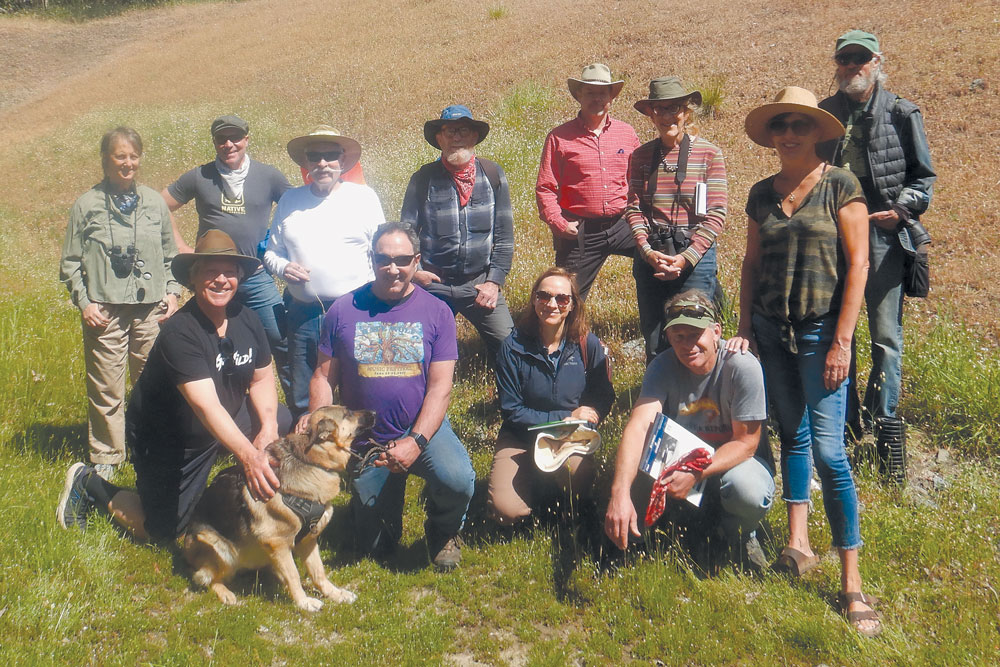Restoring Native Grass Species Can Help Reduce High-Intensity Fire Risk
Eel River Recovery Project
By Kirsten Hill and Pat Higgins
Recent California fires have been devastating, and experts tell us that such catastrophic events are likely to recur. Three causal mechanisms are: years of wildland fire suppression, impacts of climate change, and the continual spread of invasive grasses that exacerbate the intensity of fires—a factor often overlooked. The Eel River watershed has vast grasslands, and restoring native grasses and reducing invasive ones could reduce the frequency and intensity of fires and have numerous other benefits. We recently visited the North Fork Eel River watershed, and also the Tenmile Creek watershed near Laytonville. Both have substantial grasslands but different challenges for restoring native grass species.
During a visit this past May to the North Fork Eel River Wilderness with historian and archaeologist Tom Keter, we assessed the effects of the 1,614-square-mile August Complex fire, the largest in California history. Tom related that the Wailaki people, who inhabited the North Fork and watersheds west to the Pacific Ocean, used low-intensity fires for thousands of years to manage the land. Oak woodlands and grasslands were burned frequently to control Douglas-fir encroachment, resulting in an abundance of food for themselves and a wide variety of wildlife. Historically, grasslands in this wilderness were likely filled with California Oatgrass (Danthonia californica) and swathed with wildflowers. In wet meadows, Native Americans propagated gardens of Camas, one of our native lily species also known as Indian potatoes. They harvested wild clover and other “greens” from the grasslands in the spring. When ripe in summer, seeds of California Oatgrass, sunflowers (Wyethia sp.), and tarweed were combined to make a nutritious ground meal or pinole.

Bob Vassar, Steve Greenberg, Kirsten Hill, Mike Hembree, Liz Varnhagen,
Steve Brown, Michelle Barton, and Kirk Lumpkin. 5/8/21.
Native American burning was stopped by European settlers, and the tens of thousands of sheep and cows they grazed introduced a host of non-native grass species. Between 1859 and 1889, not only did the Eel River watershed grasslands change, the entire grassland ecosystem of California was transformed. Deep-rooted perennial grasses that stayed green through much of summer were swapped out for shallow-rooted annuals that dried out by late spring, reducing the forage base for animals and creating a large fuel source. Over-grazing caused compaction and gullying that further degraded meadow water storage. In aggregate, the Eel River watershed lost a huge amount of water storage, and the loss of native grasslands had ripple impacts on the aquatic ecosystem and fish.
The two watersheds I visited pose very different challenges to native grass restoration. Over 70% of the North Fork Eel watershed was burned by the August Complex Fire, and the grasslands I inspected were dominated by non-native annual grasses like soft chess (Bromus hordeaceus) and invasive plants like sheep sorrel (Rumex acetosella). Although there were some native plants, all were small and stunted in appearance, and the soil looked impoverished. The remote nature, harsh terrain, and intensive land use history make native grass restoration in the North Fork watershed very challenging, but ERRP is shaping a partnership with Six Rivers National Forest to help create a long-range plan for forest and grassland restoration.
I was heartened when I joined an ERRP field trip to the Tenmile Creek watershed in early May. We met with a group of highly knowledgeable landowners who’s own grasslands are in relatively good health, with lots of native grass species present but also substantial patches of invasive grasses. The reason native grasses were present is that the landowners have been good stewards and they are very interested in restoring them further.
ERRP’s goal of ecological restoration at the watershed scale includes grasslands. The organization will be seeking additional grants to assist landowners in restoring native grasslands using all tools available, including frequent low-intensity fire. Native grass restoration will provide better forage for livestock and wildlife and a longer grazing season, as well as increasing underground carbon storage that can help combat climate change. The fibrous deep roots of these grasses will help reduce erosion and bring moisture further into the soil and release it more slowly into the watershed. The current ERRP Tenmile Creek forest health pilot project is funded by the North Coast Resource Partnership as a Regional Forest and Fire Capacity (RFFC) demonstration project sponsored by the California Resources Agency.
For more information: www.eelriverrecovery.org
